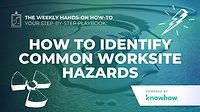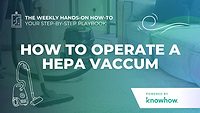Weekly Hands-on How-To powered by KnowHow
How To Establish a Safe Worksite Muster Point
Protect Your Team with a Designated Muster Point

All images provided by KnowHow.
Emergencies are unpredictable, and when things go wrong, panic can spread fast. Without a clear plan, people might scatter in different directions, making it difficult to account for everyone. That’s why a properly designated muster point isn’t just a nice-to-have—it’s a critical safety measure.
A good muster point ensures workers have a safe, organized place to gather, giving supervisors the ability to perform a headcount and coordinate next steps. But choosing the right spot requires more than just pointing to an open area. You need to consider different emergencies, potential hazards, and how to communicate the plan effectively.
In this how-to, powered by KnowHow, we’ll walk you through the process of selecting, marking, and communicating a muster point that keeps your team safe and accounted for when it matters most. Let’s get started!
Step 1: Look at the Worksite Map and Consider All Emergency Scenarios
Establishing a safe muster point starts with understanding the unique risks of your worksite. Emergencies can vary—from fires and floods to gas leaks or earthquakes—and each scenario may affect the safety of a designated location differently. A spot that’s safe during a fire might be hazardous in a gas leak.
Evaluate natural and structural hazards like trees, fences, or streams that could become obstacles during an evacuation. Also, consider the number of workers on-site and whether overcrowding could hinder safety. For larger worksites, multiple muster points may be necessary to ensure everyone has a safe and reachable gathering area.
Step 2: Go Through All "What If's"
Emergencies rarely unfold as expected, so it’s crucial to account for potential obstacles. Run through every "what if" scenario you can think of:
- What if the stairway is blocked?
- What if the elevator isn’t working?
- What if keycard access points fail?
By thinking through these possibilities, you can test whether your chosen muster point is still practical under different conditions. If a scenario renders the point unusable, you’ll need a backup plan to ensure everyone can evacuate safely.
Step 3: Select a Muster Point and Let Everyone Know
Once you’ve chosen a safe and accessible muster point, communication is key. Don’t just tell workers once and hope they remember—repetition and multiple communication methods are essential. Inform your team through various channels, such as:
- Emails
- Tailgate or safety meetings
- Project planning meetings
Ensure that every worker understands the location of the muster point and the procedures for reaching it in an emergency. Regular reminders reinforce awareness and preparedness.
Step 4: Mark the Muster Point with Clear Signage
A muster point is only effective if people can easily find it during a crisis. Install signage that is highly visible and appropriately placed:
- Height Recommendations: Mount signs between 4 to 6 feet high for standard visibility or over 8 feet in areas with vehicle traffic, such as parking lots.
- Evacuation Maps: Include the muster point and evacuation routes on posted evacuation maps within the workplace.
By clearly marking the location, you reduce confusion and help workers evacuate quickly and safely during an emergency.
Keep Your Crew Safe and Accounted For with KnowHow
Emergencies can escalate quickly, but a well-planned muster point brings order to chaos. By carefully selecting a location, accounting for potential risks, and clearly communicating the plan, you ensure that everyone on-site can evacuate safely and regroup efficiently.
With KnowHow, you can ensure your team knows exactly where to go and what to do during an emergency. From clear SOPs to on-the-job training and communication tools, KnowHow helps you keep safety procedures top of mind—so no one is left behind when it matters most.
Ready to boost your team’s preparedness? Visit tryknowhow.com today and learn how we can help strengthen your safety protocols.
Looking for a reprint of this article?
From high-res PDFs to custom plaques, order your copy today!










